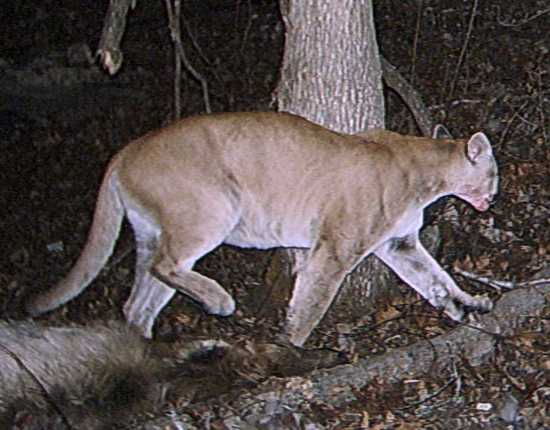Trail camera photographs mountain lion at conservation area

The Missouri Department of Conservation confirmed the sighting of another mountain lion earlier this month, bringing the number of confirmed sightings in the state to 39 since 1994.
The latest verification comes from a photo taken Feb. 2 in the Peck Ranch Conservation Area, a wildlife refuge operated by the department in portions of Carter and Shannon counties.
"The presence of that mountain lion was documented by a trail-cam photo," said Candice Davis, spokeswoman for the department's Southeast Regional Office in Cape Girardeau. "That's the best evidence we can get."
An elk calf carcass bearing signs of a mountain lion attack also was found. Conservation officials started bringing elk into Peck Ranch as part of an elk restoration effort that began in 2011.
According to information on the department's website, three counties in Southeast Missouri have the state's highest number of confirmed mountain lion sightings. Shannon County leads with six, Reynolds County has five and Carter County has four. The confirmations there and in 20 other counties across the state have been exclusively of the sub-adult male of the species, which may provide a clue as to why the mountain lions are finding their way to Missouri.
"It's their nature to take off," said Jeff Beringer, a resource scientist at the conservation department and the chairman of the agency's Mountain Lion Response Team. "The sub-adult male is known to go a long way from home in search of food or a mate, particularly if there is competition in their native habitat that forces them to do so."
To determine where the mountain lions are coming from, Beringer said hair and other samples that mountain lions in Missouri have left behind were identified in the U.S. Fish and Wildlife Service's DNA databank.
"We found matches with mountain lion families in South Dakota, Montana and Colorado," he said. "They've come a long way." Beringer feels a possible reason for the higher number of verified mountain lion sightings in Southeast Missouri is the region's topography."If I was a mountain lion, that's where I'd go," he said. "The Ozark foothills provide a remote habitat that is conducive to a mountain lion's way of life."
With the lack of female mountain lions, there is no evidence of a breeding population in Missouri. But Beringer thinks it's possible that females could enter the state in coming years.
"Nebraska went from having no confirmed mountain lions to a breeding population in 10 years," he said.
Mountain lions, also known as cougars or pumas, are naturally shy of humans and generally pose little danger to people, even in states with thriving breeding populations. Although mountain lions are protected by law, Missouri's Wildlife Code allows people to protect themselves and their property if they are threatened.










No comments:
Post a Comment